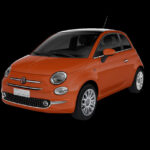
The starting point for the Fiat Spider and its Coupe sister was the 124 saloon, launched slightly ahead of them in 1966. In spite of its rather pedestrian looks this car had an exciting specification list its period. It sported disc brakes all round and a properly located live axle – four links and a Panhard rod.
Even with the live axle though the drive wasn’t perfect. The car was an understeerer that rolled like a dinghy and at low speeds on wet roads was inclined to lose its tail. In spite of all this it eventually became a Lada!
Until 1970, the saloon used a 1197 cc pushrod engine but, for the Spider and Coupe, Fiat had in mind something more special, using only the crankshaft from the pushrod motor. This was an exciting new twin-cam engine that, from some perspectives, looked suspiciously like that used by Alfa Romeo. In this engine, however, they drove the cams by a rubber belt in place of a chain. This was a really revolutionary idea when many cars still relied on pushrods. BMW had already used a single-overhead cam for its new small coupes, but hedged its bets using rockers with adjusters in them.
Fiat’s state-of-the-art twin-cam featured proper shims and buckets, race car style, but with the shims on top of the buckets so it was not necessary to pull the cams to adjust the clearances. The genius behind this brilliant concept was former Ferrari magician Aurelio Lampredi.
The engine had an iron-block and alloy-head. It grew from 1438 cc, criticised for lack of torque, to 1608 cc (1971), 1592 cc and 1756 cc (1972) and finally to 1995 cc (1978) as a DOHC four with either a single Weber carburettor or Bosch L-jetronic fuel injection introduced in 1980 and over its life power developed from 67 kW to 79 kW.
The Spider’s styling, on a saloon floorpan shortened by 140mm, was by Pininfarina, its shape an evolution of the Rondine show car which the Turin firm had produced on a Corvette chassis, and aimed squarely at the American market. Launched the same year as the Alfa Spider in 1966, sales rose from 5500 in 1967 to 15,000 in 1974, peaking at 19,931 in 1979.
In 1975 the Spider received big bumpers and, to comply with new regulations, ride height was increased. As with many Fiats of the late 1970s and 1980s they seemed to be prone to body rust. It appears that this was due to the use of sheet steel sourced from Eastern-Bloc countries.









